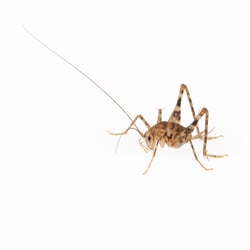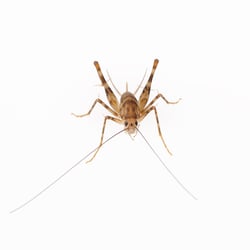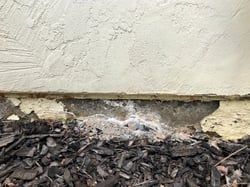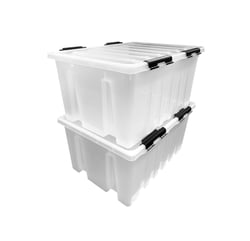Camel crickets are known by a number of different names, the most common of which being sprickets, cave crickets, and spider crickets. Despite the many names, all of these terms refer to the same insect: a curiously spider-like cricket that is often found in damp and dark areas of the home. Though camel crickets are fairly common, there is very little public knowledge about these strange looking insects. Perhaps their many names make common knowledge more difficult to come by, or maybe their misleading appearance causes confusion. Regardless, EcoShield is here to settle the question: what is a camel cricket?

Camel Cricket Biology and Physical Appearance
Part of the orthopteran order, camel crickets reside within the Rhaphidophoridae family and can be found worldwide. Their large distribution may be, in part, responsible for their nearly endless synonymous names. Known throughout the US predominantly as camel crickets, sprickets, cave crickets, or spider crickets, other parts of the world may refer to them as cave weta, Hogan bugs, criders, land shrimp, and sand treaders. Regardless of their referred name, these crickets are all flightless, nocturnal, and spider-like in appearance. In fact, camel crickets are often mistaken for wolf spiders due to their size and coloring, despite having the telltale cricket signs of six legs and large antennae. Unlike most crickets, camel crickets don’t chirp, furthering their confusion with spiders.
Camel crickets have large hind legs with thick femora and long, thin tibiae. Their legs are incredibly powerful and allow them to jump up to three feet high when they feel threatened. This unique capability causes a lot of fear for homeowners as a close inspection of the insect may result in them jumping directly into the onlooker’s face. An occurrence like this is more common than you may think! Because camel crickets enjoy dark and damp environments, they often reside in areas of the home with low visibility such as basements, crawl spaces, garages, and drainage areas. Homeowners must often get close to clearly see the insect, resulting in the camel cricket springing up in fear and seemingly “attacking” the homeowner.
Jumpiness aside, camel crickets are generally quite harmless to humans as they don’t have fangs or venom and don’t bite. That said, camel crickets are voracious omnivores that feast on quite literally anything available to them. Their insatiable appetite can cause a surprising amount of damage to homes and homeowner’s belongings. Camel crickets will gladly eat a variety of materials including fabric, carpets, wood, cardboard, trash, and even one another. Camel crickets are also known to congregate in large groups, causing their resulting damage to be quite significant.

Why do camel crickets come inside homes?
Camel crickets are not an uncommon pest for homeowners to experience, especially in the extreme hot or cold temperatures. Because they thrive in moist environments, camel crickets will often make their way into damp basements or cellars in peak summer when the ground is very dry, or during the fall and winter when the ground begins to freeze. Camel crickets are also known to overwinter in homes rather than hibernating or dying off in the freezing temps. Due to their ideal living situations being unavailable during specific times of the year, many camel crickets will move indoors to live year-round where the conditions are relatively consistent and unchanging.
Another reason camel crickets make their way indoors is for food. As hungry omnivores, basements, sheds, or garages where personal belongings are often stored can be much like an all-you-can-eat buffet to camel crickets. Unbridled access to cardboard boxes, important files and documents, and even stored clothing can be more than enough to warrant a camel cricket taking up residence. They are not picky eaters and can survive off a multitude of non-food items for their entire lifetime, which is roughly one to two years.
Occasionally, camel crickets may also end up in your home by accident. Unfortunately, even accidental visitors may take up full-time residence in your home. Once a camel cricket chooses to stay in your home, they likely won’t be a single resident for long. These insects live in large numbers and you’re extremely unlikely to experience a single camel cricket in your home. They can also reproduce rapidly; male camel crickets emit a distinct smell to attract females for reproduction. For these reasons, camel cricket infestations can occur.
 Damp indoor environment sprickets may be attracted to.
Damp indoor environment sprickets may be attracted to.
How do camel crickets get into my home?
Like many pests, camel crickets can enter your home through a variety of ways, though their most likely route is through ground-level gaps, cracks, or holes. Entry points can often be difficult to identify as they can be small and often well-hidden to the human eye. While camel crickets can technically enter through any exterior hole, here are some common entry points:
- Gaps and cracks where utility pipes or wires connect to your home
- Holes in window or door screens
- Gaps in window or door frames
- Damaged or nonexistent weatherstripping
- Cracks in your home’s foundation or siding
- Exterior ventilation units
 Crumbling foundation where sprickets may enter through.
Crumbling foundation where sprickets may enter through.
Can I prevent camel crickets?
At EcoShield, we believe prevention of pests is the single best course of action for pest-free living. While there are no one-size-fits-all solutions to pest prevention, there are many effective steps you can take to prevent camel crickets - and, by default, other pests! Bear in mind that camel crickets love damp and moist environments, so ensuring your home is moisture-free should be the first step in creating an inhospitable environment for camel crickets. In addition, some other prevention tactics include:
- Put stored dry goods in airtight glass or plastic containers.
- Recycle or throw out unneeded paper goods such as newspapers, magazines, mail, or paper bags.
- As an extra precaution, seal important documents in plastic sleeves or containers.
- Store additional clothing, blankets, sheets, or other fabric items in well-sealed plastic storage containers.
- Use plastic storage containers instead of cardboard boxes or plastic bags.
- Use dehumidifiers in basements, crawl spaces, attics, and even poorly ventilated garages.
- Ensure your home ventilation systems are running efficiently and clean any associated filters.
- Seal cracks, gaps, or holes in your doors, windows, siding, and utilities.
- Employ the help of a trusted pest professional to provide routine maintenance and identify potential problem areas.
- Utilize professional pest prevention treatments around the exterior of your home.
- Use a pest professional that provides an egg cycle service to disrupt the camel cricket life cycle and prevent any eggs from developing into adults.
 Protect personal belongings from sprickets by storing them in sealed plastic containers.
Protect personal belongings from sprickets by storing them in sealed plastic containers.
What do I do if I have a camel cricket infestation?
If you’re experiencing a current camel cricket infestation in your home, we highly recommend you seek the expertise of a trusted pest professional such as EcoShield. Camel crickets can be incredibly difficult to remove from your home, especially if there are a multitude of adults present and a new life cycle has likely begun. Infestations like this can occur quite easily as camel crickets are nocturnal creatures, and homeowners may be unaware of their presence until it’s become out of control.
There are a multitude of DIY options for removing camel crickets, however we caution against this. While DIY solutions may appear successful, this is often only temporary. In instances of infestation, you may succeed in killing off adult camel crickets, but their eggs will likely remain. These eggs will develop into nymphs and, soon after, adults. You’ll likely have to treat again for the same problem, and thus the neverending cycle begins.
Additionally, ridding yourself of the existing camel crickets is only half the battle. Though the insects may be gone, it’s crucial you address the conditions of your home that resulted in the camel cricket infestation. If you don’t identify and rectify the root cause of camel crickets entering your home, you’ll probably find yourself with another infestation in the future.
It is for these reasons that we strongly recommend you contact a reputable pest professional at the first sight of an infestation. With EcoShield’s Home Protection Plan, we not only remove the existing camel cricket infestation, but we also disrupt the lifecycle and address target locations in your home to prevent future infestations. This service protects you not only from camel crickets but a multitude of other creepy crawlies that frequently enter homes.
If you’re struggling with a camel cricket infestation, call us or fill out the form on this page for a free no obligation quote. EcoShield is here to protect you and your home from camel crickets, and many other residential pests, 100% guaranteed.
-1.png?width=250&height=188&name=MicrosoftTeams-image%20(5)-1.png)